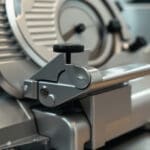When it comes to hydraulic systems, a 3 way flow divider is a game-changer for controlling fluid flow efficiently. These devices split incoming flow into multiple paths, ensuring smooth operation and precise control. Whether you’re dealing with agricultural machinery or heavy-duty construction equipment, 3 way flow divider helps maintain consistent performance.
Key Points:
– Purpose: Divides fluid flow into two or three paths.
– Application: Improves machine efficiency and synchronization.
– Industry Use: Vital in manufacturing, construction, and agriculture sectors.
The ability of these flow dividers to manage pressure differences and split flow accurately makes them indispensable in industries reliant on hydraulic systems. By balancing fluid flow among various machine components, a 3 way flow divider builds operational reliability and boosts overall productivity.
I’m Todd Cleppe, and I’ve spent over 25 years specializing in automated machinery and hydraulic solutions like the 3 way flow divider. My focus has always been on improving machinery performance efficiently and sustainably.

3 way flow divider definitions:
– adjustable hydraulic flow divider
– flow divider valves
– hydraulic priority flow divider
Understanding 3 Way Flow Dividers
Functionality of 3 Way Flow Dividers
At its core, a 3 way flow divider is designed to split the flow of hydraulic fluid into multiple pathways. This ability is crucial for maintaining balance in hydraulic systems, ensuring that each component receives the right amount of fluid to function optimally.
Flow Pathways and Fluid Control: Imagine water flowing through a garden hose. Now, picture a device that can split that flow into two or three smaller hoses, each delivering water to different parts of your garden. That’s essentially what a flow divider does, but with hydraulic fluid. It directs the fluid through different inlet and outlet ports, allowing precise control over the distribution of power within a machine.
Actuators: These devices often work in conjunction with actuators, which convert hydraulic energy into mechanical motion. By controlling the flow to different actuators, a 3 way flow divider ensures that each part of a machine operates in harmony, avoiding jerky movements or power imbalances that could lead to wear and tear.
Types of 3 Way Flow Dividers
Rotary Flow Dividers: These use rotating gears or vanes to split fluid flow. They’re known for their precision and are often used in applications where exact flow rates are crucial. Rotary dividers are robust and can handle high pressures, making them ideal for heavy-duty machinery.
Hydraulic Flow Dividers: These devices are specifically designed for hydraulic systems. They use pistons or spools to divide the flow. Hydraulic dividers are versatile and can be used in various applications, from manufacturing to agriculture. They offer excellent control over fluid distribution, ensuring each system component gets the necessary flow.
Piezo Technology: This is a more advanced type of flow divider that uses piezoelectric materials to control fluid flow. These materials change shape when an electric field is applied, allowing for very precise control. While not as common as rotary or hydraulic dividers, piezo technology offers unique advantages in applications requiring high precision and responsiveness.
In summary, 3 way flow dividers are essential for managing hydraulic fluid flow, ensuring machines operate smoothly and efficiently. Whether using rotary, hydraulic, or piezo technology, these devices provide the precision and control needed to keep machinery running optimally.
Benefits of Using 3 Way Flow Dividers
Enhancing Machinery Performance
Precision and Efficiency: A 3 way flow divider is a game changer for hydraulic systems. It ensures that each part of a machine receives the exact amount of hydraulic fluid it needs. This means machines can run smoothly without hiccups, leading to better performance and less wear and tear. Imagine a conveyor belt in a factory that moves smoothly without jerking. That’s the kind of precision these dividers bring to the table.
Synchronization and Machine Cycles: In complex machinery, different parts need to move in harmony. A 3 way flow divider helps synchronize these movements. For example, in a construction crane, the arm and hook need to move simultaneously for efficient operation. The flow divider ensures this by splitting the hydraulic fluid precisely, keeping everything in sync.
Operational Reliability: By maintaining consistent fluid flow, these dividers reduce the risk of breakdowns. This reliability is crucial in industries where downtime can be costly, like manufacturing or energy production. With a well-functioning flow divider, machines are less likely to experience unexpected stops, ensuring smooth operations.
Applications Across Industries
Manufacturing: In factories, machines often work together to produce goods. A 3 way flow divider ensures that each machine gets the right amount of fluid, optimizing the production line. This precision can lead to higher quality products and faster production times.
Construction: Heavy machinery like excavators and cranes rely on hydraulic systems to function. Flow dividers ensure these machines operate efficiently, reducing fuel consumption and increasing productivity on construction sites.
Agriculture: Tractors and harvesters use hydraulic systems to perform tasks like plowing and harvesting. By using a 3 way flow divider, farmers can ensure their equipment runs efficiently, helping them get the job done faster and more effectively.
Energy: In the energy sector, machinery used for drilling or turbine operation requires precise fluid control. Flow dividers help manage this, ensuring the equipment operates at peak performance, which is vital for energy production and distribution.
In summary, the use of 3 way flow dividers improves machinery performance across various industries by providing precision, synchronization, and reliability. Whether in manufacturing, construction, agriculture, or energy, these devices play a crucial role in optimizing operations and ensuring efficient machine cycles.
How to Choose the Right 3 Way Flow Divider
Selecting the right 3 way flow divider is crucial for ensuring optimal performance in hydraulic systems. Here are key specifications and considerations to guide your decision:
Key Specifications to Consider
Pressure Ratings: When choosing a flow divider, ensure it can handle the maximum operating pressure of your system. For instance, the Parker B10-3-8B model can withstand up to 5000 psi (350 bar), making it suitable for high-pressure applications.
Flow Range: The flow rate is essential for maintaining system efficiency. The flow rate capability of a flow divider should match the requirements of your hydraulic system. This ensures each component receives the correct amount of fluid.
Material Construction: The choice of material impacts durability and performance. Steel bodies, like those used in Parker’s models, are ideal for high-pressure environments, while anodized aluminum is suitable for lower-pressure applications.
Connection Size and Type: Ensure compatibility with your existing hydraulic system by checking the connection size and type. For example, Parker’s flow dividers use -8 SAE connections, which are standard in many systems.
Custom Solutions for Specific Needs
For unique applications, custom configurations may be necessary. Prototype machines or individual valve usage often require custom solutions to meet specific performance criteria. Companies like CFAB Global offer customization options to ensure the flow divider fits perfectly into your system.
Whether you need a standard solution or a custom setup, understanding these specifications will help you choose the best 3 way flow divider for your needs. This attention to detail not only improves system performance but also ensures long-term reliability.
By considering these factors, you can optimize your hydraulic systems for efficiency and effectiveness, ensuring smooth operations across various applications.
Frequently Asked Questions about 3 Way Flow Dividers
What is the function of a 3-way flow control valve?
A 3-way flow control valve is designed to manage the flow of hydraulic fluid within a system. It directs fluid to different parts of a machine, such as an actuator, by opening or closing pathways. This is crucial for controlling the movement and speed of machinery components. The valve also serves an exhaust function, allowing excess fluid to exit the system, which helps maintain pressure balance and prevents system overload.
How does a flow divider work?
A flow divider operates by splitting hydraulic fluid into multiple flow paths, ensuring each pathway receives a specific amount of fluid. This is particularly important when you need to synchronize the movement of different actuators or machine parts. The divider balances pressure differences within the system, allowing for precise control over fluid distribution. This process helps maintain efficiency and consistency in machine operations, as seen in hydraulic systems using devices like the Parker B10-3-8B.
What are the common problems with flow dividers?
Flow dividers, while essential for fluid control, can encounter several issues:
-
Bypassing: This occurs when fluid leaks past the divider, leading to uneven distribution. It can result in reduced efficiency and performance inconsistencies.
-
Synchronization Issues: If the flow divider isn’t functioning correctly, it can cause parts of the machine to move out of sync. This can lead to mechanical failures or decreased operational efficiency.
-
Flow Divider Tightness: Over time, wear and tear might affect the tightness of the flow paths, causing leaks or blockages. Regular maintenance and inspection can prevent these problems, ensuring the flow divider remains effective.
Understanding these aspects of 3 way flow dividers can help you troubleshoot issues and maintain optimal performance in hydraulic systems. Proper selection and maintenance of these components are key to enhancing machinery reliability and efficiency.
Conclusion
At CFAB Global, we understand that the key to operational efficiency lies in precision and reliability. Our Machine Reliability Program is designed to ensure that your machinery components, including 3 way flow dividers, perform at their best. This program offers a custom approach to maintenance, focusing on predictive strategies that minimize downtime and extend the lifespan of your equipment.
By integrating advanced solutions like 3 way flow dividers, businesses across various industries—from manufacturing to agriculture—can achieve synchronized machine cycles and improved operational efficiency. These components are critical in maintaining the balance and flow of hydraulic systems, ensuring that machinery operates smoothly and efficiently.
Our expertise at CFAB Global goes beyond just providing equipment. We work closely with our clients to offer custom solutions that meet specific industry demands. Whether you need help selecting the right flow divider or require support for ongoing maintenance, our team is here to assist you every step of the way.
For those looking to improve their machinery’s performance and reliability, CFAB Global is your go-to partner. Our comprehensive services, coupled with our commitment to excellence, ensure that your operations remain productive and efficient.
Find more about how our solutions can benefit your business by visiting our Graco service page. Let us help you achieve maximum productivity and operational success.






